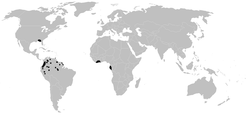Neogoveidae
| Neogoveidae | |
|---|---|
| Scientific classification | |
| Kingdom: | Animalia |
| Phylum: | Arthropoda |
| Class: | Arachnida |
| Order: | Opiliones |
| Suborder: | Cyphophthalmi |
| Superfamily: | Ogoveoidea |
| Family: | Neogoveidae Shear, 1980 |
| Genera | |
|
see text | |
| Diversity | |
| 5 genera, 12 species | |
 | |
The Neogoveidae are a family of harvestmen with twelve described species in five genera. However, at least seven species of Huitaca, 17 species of Metagovea and twelve species of Neogovea are currently awaiting description.[1]
Description
Neogoveidae are 1 to almost 5 mm long and eyeless.[2]
Distribution
They occur between 10° north and 5° south of the equator in South America and Africa, with the exception of Metasiro, which is found in Florida.[2] Metasiro is most closely related to species from West Africa. Florida was part of Western Africa near what is today Senegal prior to the formation of Pangea. When North America parted from West Africa about 170 million years ago, it took Florida and its harvestmen with it.[3]
Current research[4] suggests that the diversity of neotropical Neogovidae is much higher than currently known, as new species were found at virtually every place where samples were taken.
Huitaca species have been found in Colombia at elevations ranging from 300 m to more than 3,000 m. Neogovea is found from Trinidad, the lowlands of the Amazonas and Orinoco basins, but also at higher elevations in the Colombian Andes and Venezuela. Metagovea species live mostly along the Andes, but a few are found in the Amazonas basin.[4]
Relationships
Molecular studies suggest that the American species are monophyletic, forming a sister group to the African species, and that those two are themselves related to the North American Metasiro.[2]
Name
The name is a combination of Ancient Greek neo "new" and Ogoveidae.
Species
- Huitaca Shear, 1979 (Colombia)
- Huitaca bitaco Benavides & Giribet, 2013
- Huitaca boyacaensis Benavides & Giribet, 2013
- Huitaca caldas Benavides & Giribet, 2013
- Huitaca depressa Benavides & Giribet, 2013
- Huitaca sharkeyi Benavides & Giribet, 2013
- Huitaca tama Benavides & Giribet, 2013
- Huitaca ventralis Shear, 1979
- Metagovea Rosas Costa, 1950
- Metasiro Juberthie, 1960 (Florida, Georgia, South Carolina)
- Metasiro americanus (Davis, 1933)
- Neogovea Hinton, 1938
- Neogovea immsi Hinton, 1938 (Pará, Brazil; under logs in moist forest)
- Neogovea kamakusa Shear, 1977 (Essequibo District, Guyana)
- Neogovea kartabo (Davis, 1937) (Kartabo, Guyana)
- Neogovea microphaga (Martens, 1969) (Brazil)
- Parogovia Hansen, 1921 (Gulf of Guinea, Sierra Leone)
- ?Genus enigmaticus Martens, 1969 — not assigned to a genus yet, because no males are known; possibly Neogovea.
The following species is no longer considered to belong in this family, but has not yet been included in any other:[1]
Footnotes
References
- Joel Hallan's Biology Catalog: Neogoveidae
- Checklist of the Cyphophthalmi species of the World
- Shear, W.A. (1977): The opilionid genus Neogovea Hinton, with a description of the first troglobitic cyphophthalmid from the Western Hemisphere (Opiliones,Cyphophthalmi). Journal of Arachnology 3: 165-175. PDF
- Giribet, G. & Boyer, S.L. (2002): A cladistic analysis of the cyphophthalmid genera (Opiliones, Cyphophthalmi). Journal of Arachnology 30: 110-128. PDF
- Pinto-da-Rocha, R., Machado, G. & Giribet, G. (eds.) (2007): Harvestmen - The Biology of Opiliones. Harvard University Press ISBN 0-674-02343-9
- Benavides, Ligia & Giribet, Gonzalo (2007): An illustrated catalogue of the South American species of the cyphophthalmid family Neogoveidae (Arthropoda, Opiliones, Cyphophthalmi) with a report on 37 undescribed species. Zootaxa 1509: 1-15. PDF
Further reading
- Legg, G. (1990): Parogovia pabsgarnoni, sp. n. (Arachnida, Opiliones, Cyphophthalmi) from Sierra Leone, with notes on other African species of Parogovia. Bul. Br. Arachnol. Soc. 8: 113-121.